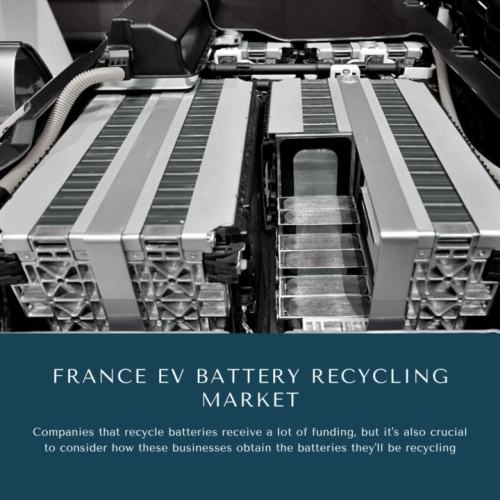
- Get in Touch with Us

Last Updated: Apr 25, 2025 | Study Period: 2024-2030
The manufacturing of large batteries is increasing to power EVs. Companies that recycle batteries receive a lot of funding, but it's also crucial to consider how these businesses obtain the batteries they'll be recycling.

EV batteries have a lifespan of 10 to 13 years, so even while they might not be ready for mass recycling just yet, we know it's coming. To accommodate this need, businesses all around the world are already investing in recycling facilities.
The France EV Battery Recycling Market accounted for $XX Billion in 2021 and is anticipated to reach $XX Billion by 2026, registering a CAGR of XX% from 2024 to 2030.
A recycling plant for electric car batteries might be built in France by the French mining corporation Eramet and Suez. Eramet, a significant manufacturer of nickel and manganese for the steel industry, has shifted its attention increasingly to components for electric cars.
In an extended relationship, environmental services company Suez and Eramet will research industrial-scale recycling options this year with the goal of establishing a lithium-ion battery recycling facility in France. T
he combined project would result in the production of black mass, a metal concentrate suited for hydrometallurgical processing that contains nickel, cobalt, manganese, lithium, and graphite. Eramet will independently consider building a refinery to transform the black mass into battery-grade products.
A cooperation between Groupe Renault, a major participant in the automotive industry, Veolia, a worldwide leader in resource optimization, and Solvay, a major science-based corporation, to allow the circular economy of EV battery metals in Europe through closed-loop recycling was announced.
The three partners are working to provide a sustainable and secure source of supply for critical battery metals including cobalt, nickel, and lithium.
The businesses intend to accomplish this by utilizing their individual expertise at each stage of the value chain, from the collection of used electric vehicle batteries to the dismantling, metal extraction, and purification processes, as well as by improving the current mechanical and hydrometallurgical battery recycling processes.
Strategic metals that were previously recovered in a form only suitable for metallurgical applications will be extracted and purified into high-purity metals ready to be reused in new batteries through Solvay and Veolia's collaborative innovative technology, reducing the environmental impact of future EV batteries through this closed loop.
| Sl no | Topic |
| 1 | Market Segmentation |
| 2 | Scope of the report |
| 3 | Abbreviations |
| 4 | Research Methodology |
| 5 | Executive Summary |
| 6 | Introduction |
| 7 | Insights from Industry stakeholders |
| 8 | Cost breakdown of Product by sub-components and average profit margin |
| 9 | Disruptive innovation in the Industry |
| 10 | Technology trends in the Industry |
| 11 | Consumer trends in the industry |
| 12 | Recent Production Milestones |
| 13 | Component Manufacturing in US, EU and China |
| 14 | COVID-19 impact on overall market |
| 15 | COVID-19 impact on Production of components |
| 16 | COVID-19 impact on Point of sale |
| 17 | Market Segmentation, Dynamics and Forecast by Geography, 2024-2030 |
| 18 | Market Segmentation, Dynamics and Forecast by Product Type, 2024-2030 |
| 19 | Market Segmentation, Dynamics and Forecast by Application, 2024-2030 |
| 20 | Market Segmentation, Dynamics and Forecast by End use, 2024-2030 |
| 21 | Product installation rate by OEM, 2023 |
| 22 | Incline/Decline in Average B-2-B selling price in past 5 years |
| 23 | Competition from substitute products |
| 24 | Gross margin and average profitability of suppliers |
| 25 | New product development in past 12 months |
| 26 | M&A in past 12 months |
| 27 | Growth strategy of leading players |
| 28 | Market share of vendors, 2023 |
| 29 | Company Profiles |
| 30 | Unmet needs and opportunity for new suppliers |
| 31 | Conclusion |
| 32 | Appendix |